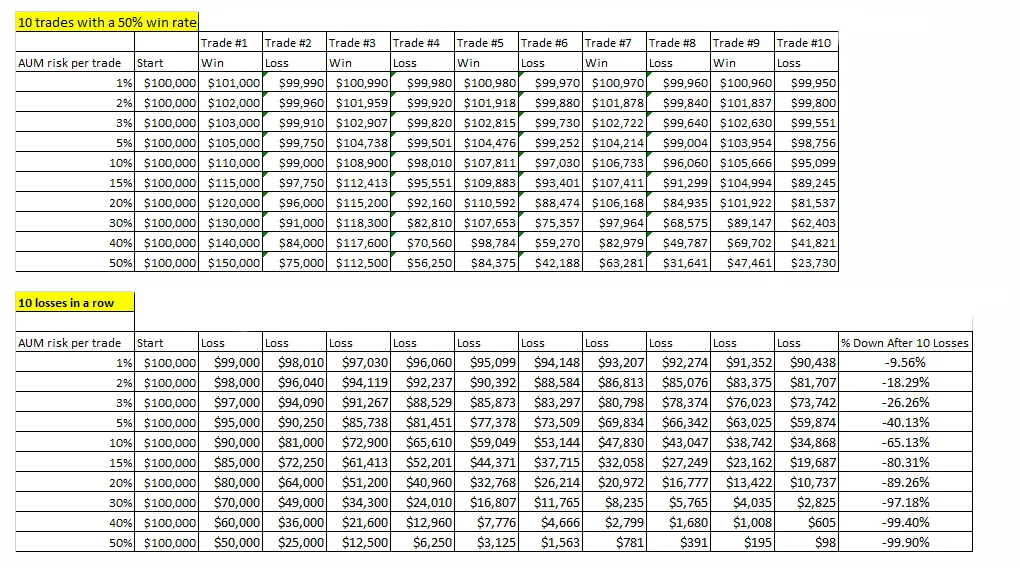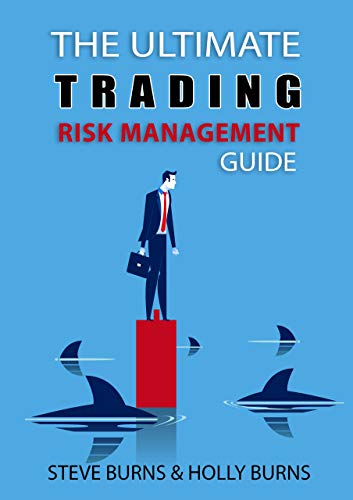Here are ten ways to limit your risk exposure and minimize the size of your trading losses.
1. Never lose more than 1% of your total trading capital on a single trade.
‘The very first rule we live by is: Never risk more than 1% of total equity on any trade.” -Larry Hite
“I try very hard not to risk more than 1% of my portfolio on a single trade.”–Bruce Kovnar
One of the most important lessons that a trader must follow to ensure his long term success, is to never risk more than 1% of his trading account on any one trade. This does not mean trading with 1% of your account capital, that is position sizing not risk per trade. Never losing more than 1% on a trade means adjusting your stop losses and position sizes based on the volatility of your stock, currency, commodity, option, or future contract, so that when you are wrong the consequences are the loss of 1% of your trading capital. This not only almost eliminates your risk of ruin for a string of losing trades, but also lowers your stress level so you can think and trade with a clear mind, and not have your emotions take over.
2. Position sizing.
I base my position sizing in my trades on the fact that I never want to lose more than 1% on any one trade. If I am trading with a $100,000 account, I don’t want to lose more than $1,000 in a losing trade. A stop loss level has to start at the price level that you know you are wrong, and work back to position sizing. If the support level on your trade is $105 for your entry and you set your stop at $100, then you can trade 200 shares with a stop at the $100 price level. 200 X $105 = $21,000 position size for 200 shares. This is about 20% of your total trading capital with about a 5% stop loss on your position that equals a 1% loss of your total trading capital.
- A 20% position of your total trading capital gives you a potential 5% stop loss on your position to equal 1% of total trading capital.
- A 10% position of your total trading capital gives you a potential 10% stop loss on your position to equal 1% of total trading capital.
- A 5% position of your total trading capital gives you a potential 20% stop loss on your position to equal 1% of total trading capital.
The average true range (ATR) can give you the daily range of price movement and help you position size based on your time frame and your stocks volatility. If your entry is $105, your stop is $100, and the ATR is $1, then you have a five days worth of movement against you as a stop.
Start with your stop loss level and volatility to give yourself your position size. The more room you want on your stop determines how big of a position size you can take.
If you only risk losing 1% of your trading capital when you are wrong, then every trade can become just one of the next 100 with little emotional impact. Ultimately, you can survive losing streaks and increase your odds of prosperity.
3. Never risk your lifestyle on a single trade.
“Speculate with less than 10% of your liquid net worth. Risk less than 1% of your speculative account on a trade. This tends to keep the fluctuations in the trading account small, relative to net worth. This is essential as large fluctuations can engage {emotions} and lead to feeling-justifying drama.”- Ed Seykota
4. Avoid the risk of ruin.
Your risk of ruin is the probability that you’ll lose so much money you can no longer continue trading due to financial or emotional reasons. It doesn’t always mean losing all of your trading capital, your personal breaking point is determined by your own personal risk tolerance pain threshold, one person could be ruined after a 50% drawdown from an equity peak while others may quit the first time their capital drops 20% from their starting point. Others will recapitalize and never quit until they are successful.
5. A diversified trading system can limit risk of over exposure to just one asset class.
Equities are just one asset class. Stocks are the place to be when their are expectations of growing corporate earnings and the economy is in a growth phase with low interest rates. Over their history stocks have on average been up in ten year periods and have beaten most other asset classes overall in the long term but this is based on buy and hold not ‘trading’ and there are many times where stocks are not the place to be in 20% bear market corrections and the 10 year flat periods where you lose money and inflation eats up your buying power.
Money is made by capturing trends inside your trading/investing time frame. The better the entry and the longer the time frame the better chance of profits for most people. Stocks do not always trend, but there are usually trends somewhere if you expand your watch list, systems, and back-tests. Along with equities there is also the forex, futures, the bond market, and option contracts. The reason trend followers trade multiple markets is to give them a high probability of catching those out sized trends and create the big outlier profits. If you are only trading one market and it is not conducive to making you money with your system then you limit your possibilities and decrease your probabilities of success. Trading markets that are not correlated gives you a wider range of opportunities with different types of price action in each.
People that trade only stocks have a larger amount of correlation risk than they realize, especially if they are long only traders. Here is where they get into trouble: they are holding five stocks at the same time and the market gaps down, if they have stop losses in place and are risking 1% of their capital per stop and all five are triggered at the same time suddenly their whole account is down 5% in one day. If they are risking more of their capital than 1% or have more then five positions on at one time they can be severely hurt in a big stock market draw down. If they were holding only one equity position, along with gold, oil, bonds, or a currency the odds are that they would not be hurt as these assets are generally not correlated and it would be rare for all to go against the trader at once. Also holding both long positions and short positions can help diversify a portfolio and lower correlation risk.
6. Risk / Reward Ratios
Your expectation of reward on a trade entry should always be a multiple of the risk on your stop loss placement. Risking one dollar to make three of more is a better strategy of risk management than risk a lot to make a little. The reward has to be worth the risk taken.
7. Avoid big losses they are the number one cause of unprofitable trading.
Here is an example of the different equity curves with the same winning percentage but based on different sizes of wins and losses. Also what happens with ten losses in a row based on higher risk% to capital

For more information check out my book-> The Ultimate Guide to Risk Management.

